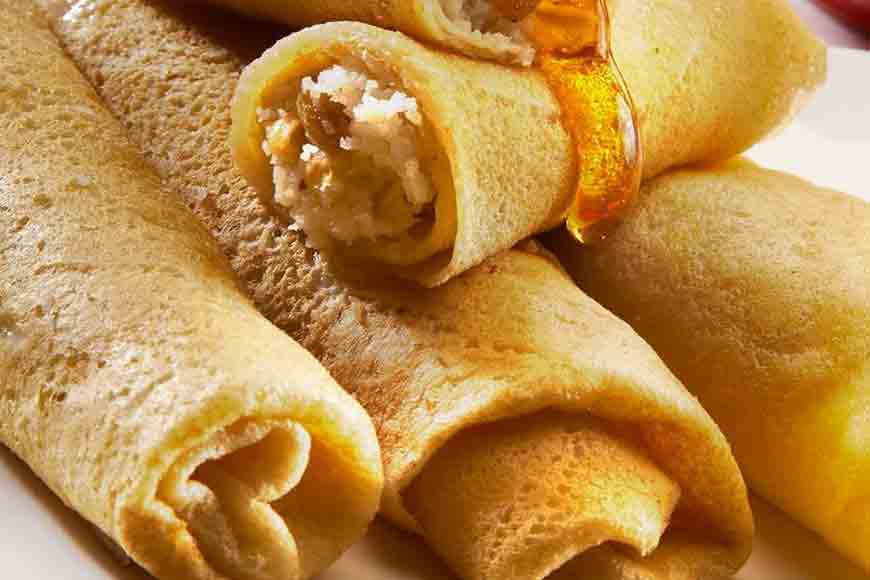Alpana motifs and sweet nothings of Nabanna

For those who are used to savouring pancakes, here is some Bangla version to it. The Nabanno festival is here and a major part of the rituals is food: Pithe and Puli. This is done to celebrate the harvest season. It begins early in the morning with the women of the house getting together. An earthen pot of water with a handful of rice seeds soaked in the water overnight is carried to every corner of the house and all the rooms. The water is sprinkled everywhere with the help of a mango twig. This is called Mangolik. Then they decorate the dhenki (the wooden beam used for pounding rice) and perform Boron rituals (extending a formal welcome ceremony). One of the women pounds the first batch of rice and throws a fistful into the air as an offering to the Gods. The rest is taken home, where some of it is used to etch intricate alpana motifs on all the precious possessions of the family.
Offerings are made to the animals, to the deities or gods and to fire. Preparing dishes from the new crop is a symbol of respect and thanks-giving to the Goddess of crops, Lakshmi. Food is offered to crows. Cooked payesh is laid out by the river as offerings for birds and other stray animals because this is believed to ensure peace and prosperity at home. The first batch of pithe is made with the rice offered to the gods and the first is fed to the family’s cow and then begins the feasting, starting with the ritualistic nabanna -- a blending of uncooked harvest produce including rice, coconut and moong dal -- and moving on to the main attraction, the pithe.

We share the Bengali pancake: Patishapta recipe today
Patishapta Recipe
Time: 45 minutes
Ingredients for Filling:
Desiccated coconut: 2 ½ cups
Jaggery: 1 cup/ or sugar
Condensed Milk: 1½ cup or 400ml
Cardamom powder: ½ tsp
Dry fruits: according to your choice
Khoya: 1/3 cup
Sugar: if necessary
Preparation for Filling:
• Make tiny pieces of the jaggery. It will help the coconut to blend with it faster.Take a large pan and heat on medium flame.
• Add desiccated coconut and dry roast for 2-3 minutes on medium-low flame.
• Add jaggery/sugar/condense milk into pan, whichever you are using.Try to mix it with the coconut flakes.
• Once the jaggery-coconut mixture is not sticking to the pan any more, add Khoyaand keep stirring continuously on medium-low flame. Once khoya is mixed completely, increase the flame to medium and stir non-stop for 1-2 minutes.
• Add dry fruits.
• Switch off the flame, sprinkle cardamom powder and transfer immediately into a flat wide palate to cool off.
Ingredients for Crepes:
Flour: 1 cup
Rice powder: 6 tablespoon
Semolina: 5 tablespoon
Caster Sugar: 1 tablespoon
Cardamom essence: 2-3 drops
Milk: 2½ cup + 1/3 cup (if necessary)
Preparation for Crêpes:
• Sieve and sift the flour in a deep bottomed bowl. Add semolina and caster powder.
• Add milk slowly to make a thick paste. Add very small amount of milk to avoid lumps. Break the lumps, if any, and mix well with a fork.Once the batter is lump-free and smooth, add more milk and keep mixing to form a very balanced batter.
• Take a non-stick flat pan or tava. Put a few drops of ghee on it. Place a ladle full of batter on the pan and rotate the pan to cover the surface with the batter.
• Keep the flame on low, otherwise the crêpes will turn brown. Once the crêpe changes the color to pale golden, carefully flip it and allow the opposite side to cook.
Assembling the Patishapta:
• Take 1-2 tablespoon of the filling prepared before in your palm and make a flat rectangle pattie.
• Flip the crêpe again and place the pattie gently on a round edge of the crêpes.
• Now turn the edge inner-wards and roll the crêpe on the opposite direction. (far from you.). Roll until you reach the other edge. Press it gently with the spatula to give it a shape of a frankie.
• Flip the frankie and press gently again. Your Patishapta is ready!









